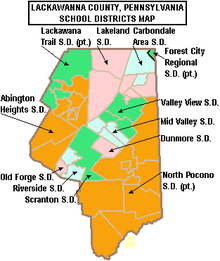| Scranton School District | |
|---|---|
 The school district administration building | |
| Address | |
425 N Washington Ave
, Pennsylvania, 18503United States | |
| District information | |
| Type | Public |
| Grades | Pre-K–12 |
| Schools | 15, including Scranton High School and West Scranton High School |
| Budget | $216.5 million |
| NCES District ID | 4221090[1] |
| Students and staff | |
| Students | 9,273 (2021-2022) |
| Teachers | 669 |
| Student–teacher ratio | 14:1 |
| Athletic conference | Lackawanna League |
| Other information | |
| Website | www |

The Scranton School District is a large, urban school district located in Scranton, Pennsylvania in the Wyoming Valley region of northeastern Pennsylvania. It serves all of the city of Scranton in Lackawanna County, Pennsylvania.[2] The district encompasses approximately 26 square miles. According to the 2020 census, the Scranton School District serves a resident population of 76,997. [3] The educational attainment levels for the Scranton School District population (25 years old and over) were 83.9% high school graduates and 19.3% college graduates.[4] The district is one of the 500 public school districts of Pennsylvania.
According to the Pennsylvania Budget and Policy Center, 63.7% of the district's pupils lived at 185% or below the Federal Poverty Level [1] as shown by their eligibility for the federal free or reduced price school meal programs in 2012.[5] In 2013, the Pennsylvania Department of Education, reported that 145 students in the Scranton School District were homeless.[6]
In 2009, Scranton School District residents’ per capita income was $16,174, while the median family income was $39,233.[7] In the Commonwealth, the median family income was $49,501[8] and the United States median family income was $49,445, in 2010.[9] In Lackawanna County, the median household income was $43,673.[10] By 2013, the median household income in the United States rose to $52,100.[11] In 2014, the median household income in the USA was $53,700.[12]
The Northeastern Educational Intermediate Unit IU19 provides the district with a wide variety of services like: specialized education for disabled students; state mandated training on recognizing and reporting child abuse; speech and visual disability services; criminal background check processing for prospective employees and professional development for staff and faculty.
- ^ "Search for Public School Districts – District Detail for Scranton SD". National Center for Education Statistics. Institute of Education Sciences. Retrieved 2023-02-09.
- ^ "2020 CENSUS - SCHOOL DISTRICT REFERENCE MAP: Lackawanna County, PA" (PDF). U.S. Census Bureau. Archived (PDF) from the original on October 9, 2022. Retrieved 2024-11-01. - Text list
- ^ US Census Bureau, 2020 Census Poverty Data by Local Education Agency, 2013
- ^ proximityone (2014). "School District Comparative Analysis Profiles".
- ^ Pennsylvania Budget and Policy Center, Education Facts Student Poverty Concentration by LEA, 2012
- ^ Collin Deppen (January 2015). "How many children are homeless in your school district?" (PDF). Pennsylvania Department of Education.
- ^ US Census Bureau, American Fact Finder, 2009
- ^ US Census Bureau (2010). "American Fact Finder, State and County quick facts".
- ^ US Census Bureau (September 2011). "Income, Poverty, and Health Insurance Coverage in the United States: 2010" (PDF).
- ^ US Census Bureau (2014). "Pennsylvania Median household income, 2006-2010 by County".
- ^ Michael Sauter & Alexander E.M. Hess (August 31, 2013). "America's most popular six-figure jobs". USA Today.
- ^ Jeff Guo (September 15, 2015). "Lower wages for whites, higher wages for immigrants, and inequality for all". The Washington Post.